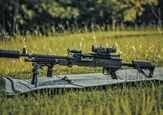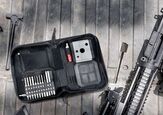Chinese AKs - The Most Controversial Kalashnikov Variant. Part 2 – How Type 56 Took Over the World

In Part 1 of this article, I talked about early Chinese AKs and the humble beginnings of Kalashnikov rifle manufacturing in China. By 1956, China was building new factories and improving old ones with the help of Soviet engineers, and it seemed like nothing can break apart two great comrades – the Soviet Communist party and their Chinese counterparts.
But while engineers were building factories in the middle of nowhere and Chinese workers were figuring out the intricacies of modern mass production, something else was happening far away from Chinese industry towns. Something that would change the course of history for the Chinese small arms industry.
AK History @ TFB:
In Moscow, in February 1956, during the 20th Congress of the Communist Party of the USSR, Soviet leadership suddenly acknowledged something no one expected to hear. Apparently, GULAGs, hundreds of thousands of mass executions, millions of arrests, and mass torture – all the things that were carried out by Stalin and his comrades, weren’t exactly an essential part of the plan to build a better Communist society.
Stalin and his cult of personality were officially denounced by the Soviet communist party, and the new party line was distributed among all the left-wing parties of the world. Obviously, Chinese comrades couldn’t tolerate such a blatant betrayal of core Communist values and the relationship between the two countries collapsed.
From the early 60s, the Chinese small arms industry was on its own. Now, if they wanted to get Soviet technology, they had to steal and reverse-engineer it. Even when chairman Mao Zedong finally joined the ranks of good communists in 1976, the relations between the countries did not improve.
The First Chinese-designed AK variants
By 1959, Soviet factories were switching to stamped receivers on their AKs. Chinese weapon design engineers had to figure out the design themselves. First of all, they used a thicker, 1.5 mm sheet metal for the receiver. The exact reason for that is unknown, but most likely 1.5 mm steel was simply more durable, especially if you expect that steel made at the new Chinese factories wouldn’t always have perfect quality.
When the Soviets first began production of AK 47 in 1949, they faced the same problem. Soviet steel just wasn’t good enough for mass production of stamped receivers, so within two years they had to switch to milled receivers and abandon the idea of the stamped receiver on an AK until 1959.
Apart from receiver thickness, the rivet pattern on the front of the receiver is noticeably different on Soviet and Chinese-made rifles.
The stamped Type 56 was a solid and durable rifle that was exported to the most remote and unwelcoming corners of the world. The Chinese AKs made for their own People’s Liberation Army (PLA) had hieroglyphs stamped on the right side of the receiver to mark the positions of the selector lever. The guns made for the export had markings L and D instead. “Full auto“ translates into 连/Lián (L), and “semi-auto” translates into 单/Dān (D).
Generally, Chinese AKs made for PLA had slightly better quality. I inspected hundreds of those guns in Afghanistan, they were issued to guards at one of the most important projects. Those rifles were truly a blessing for me in that country. The biggest challenge I faced as an armorer in Afghanistan was fake Pakistani-made AKs. Meaning that when you pick up a Russian AK in Kabul, there is a 50% chance that it is fake, and even if it is real, most probably, all of the internals were replaced with cheap locally made parts, so it is still gonna blow up in your hands when you attempt to fire it.
But when you pick up a Chinese AK, you don’t have that risk. Pakistani gunsmiths never attempted to copy Chinese guns, so when you see hieroglyphs on the receiver you know it is original.
Another notable feature of this generation of Chinese AKs was the “spiker”. The idea was quite simple – Chinese weapon designers simply took a Chinese SKS bayonet mechanism and copy-pasted it on an AK with a wooden stock. Personally, I cannot attest to the effectiveness of this feature, but the bayonet sure looks intimidating.
In the early 80s, around 1983, semi-automatic Chinese AKs started to come to the US civilian market. There were many different importers, and if you want to know more, check out this excellent Chinese AK-47 Blog. It documents information about all the importers and all the different variants of Chinese AKs that were available in the US.
Unfortunately, good times never last, and in 1994 the importation of Chinese AKs to the US stopped. The Bureau of Alcohol, Tobacco, and Firearms accused Norinco, a Chinese exporter of shipping illegal guns to the country. Since then Chinese AKs became collectible and the prices are rising every year.
The Propagation of Chinese AKs
There was one dimension of the Chinese AK export. They didn’t just sell the guns, they sold the technology. Several countries obtained the capability of domestic firearm manufacturing with China’s help.
The first recipient of China’s AK technology was Albania. After this country left the Warsaw Pact in 1968 and cut ties with the Soviet Union, the Albanian communist government had only one strong shoulder to lean on – China. And China didn’t disappoint. In just a few years, around 1974, Albania began production of Automatiku Shqiptar model 56, a copy of Chinese Type 56.
Production continued until the early 1990s. Following the collapse of the communist government and economic disaster, in 1997, many of those rifles were looted from the government arsenals and ended up in different corners of the world. I first encountered Albanian AKs in Afghanistan, and a few years later my friend and fellow TFB writer Miles had exactly the same encounter.
The practice of technology transfer continued and in the next few decades Sudan, Iran, and Algeria received the same technology package. But that is a story for another time.
At the end of the XX century, the world was changing. The Soviet Union collapsed, and the Cold War ended, which opened a lot of opportunities in the global firearms market. The Chinese adapted like nobody else, and Chinese AKs were at forefront of those changes, which I will talk about in Part 3 of this article.

Vladimir Onokoy is a small arms subject matter expert and firearms instructor. Over the years he worked in 20 different countries as a security contractor, armorer, firearms industry sales representative, product manager, and consultant. His articles were published in the Recoil magazine, Small Arms Review, Small Arms Defence Journal, and Silah Report. He also contributed chapters to books from the "Vickers Guide: Kalashnikov" series. Email: machaksilver at gmail dot com. Facebook: https://www.facebook.com/Vladimir-Onokoy-articles-and-videos-about-guns-and-other-unpopular-stuff-107273143980300/ Instagram: https://www.instagram.com/vladonokoy/ YouTube: https://www.youtube.com/user/machaksilver
More by Vladimir Onokoy




























Comments
Join the conversation
Well, if anyone is better at mass manufacture of arms than the Russians, it's the Chinese.
I'm not gonna claim to be an AK expert or really "know" why the Chinese went with a 1.5mm receiver. But looking over a 1mm and 1.5mm receiver myself, my educated guess is they did it for simpler production.
The milled AK receivers had 1.5mm walls where the fire control pins went through, and the thickness has a part to play in properly retaining the pins. Part of the whole idea behind the AKM for the Russians was reduced weight, and I guess they decided that 1mm was the thinnest they could make the receiver to reduce weight and still have it be strong enough for their purposes. And in order for the guns to still be able to use the same fire control pins as the old AK, they added the X and Y stampings around the holes to make the receiver effectively 1.5mm thick in that area.
The Chinese, being the Chinese ofcourse prioritized penny pinching over chasing ounces. Those X and Y stampings were extra steps and complexity that was unnecessary. If the original milled receiver had 1.5mm walls then just make the stamped receiver have 1.5mm walls and get on with it.
This is exemplified by the fact that most every other part of the rifle besides the receiver remained the same between the milled and stamped versions, unlike the AKM that got a lighter barrel, thinner front sight tower and gas block, thinner top cover, etc. To the Chinese it wasn't about making the rifle lighter, but simply making it cheaper.